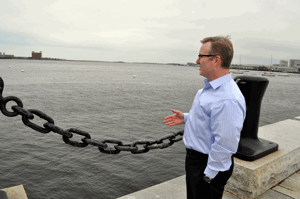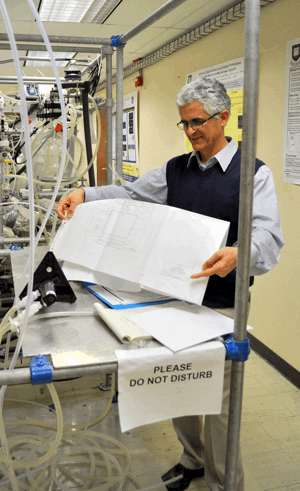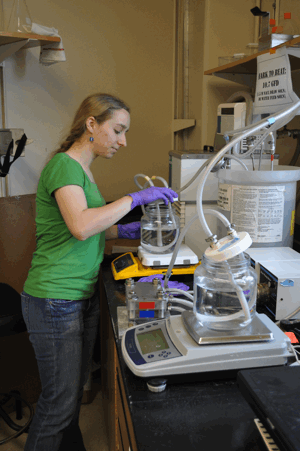Low Salt Water with Low Energy Technology
Air Date: Week of January 14, 2011

Rob McGinnis of Oasys Water hopes to market his forward osmosis desalination technology in the near future. (Photo: Lisa Raffensperger)
Desalination provides fresh drinking water for millions of people a day, but current technology to remove salt from seawater is extremely energy intensive. Now, a team at Yale has developed a low-energy method of desalination that could produce fresh water at half the price of existing methods, and use just one-tenth as much electricity. IEEE Spectrum and the National Science Foundation’s Lisa Raffensperger has our story.
Transcript
GELLERMAN: It’s Living on Earth, I’m Bruce Gellerman. Desalination, the process of removing salt from seawater, provides 16 billion gallons of purified water to the world every day. For some countries, including Kuwait and Saudi Arabia, desalination is already the primary source of water. There’s clearly enough ocean to satisfy the rising demand but a major limiting factor is the cost of energy for the process. Now engineers at Yale University have come up with a more efficient method of desalination, which produces fresh water at less than half the price. Lisa Raffensperger of the IEEE Spectrum, National Science Foundation program, "The Water-Energy Crunch: A Powerful Puzzle," reports.
[HARBOR SOUNDS: WATER, BOATS]
RAFFENSPERGER: As the winds pick up over Boston Harbor, engineer Rob McGinnis stands on the dock. He sweeps his arm toward the bustling waterfront.
McGINNIS: …container ships loading up not far from here, cruise ships coming in….we have the airport right next to the water, we have power plants which use the water for cooling purposes.

Rob McGinnis of Oasys Water hopes to market his forward osmosis desalination technology in the near future.
(Photo: Lisa Raffensperger)
RAFFENSPERGER: But for all the things this water is good for—
McGINNIS: It’s not good for drinking.
RAFFENSPERGER: As chief technology officer of the Oasys Water company, McGinnis will tell you that’s not strictly true. Desalination makes seawater drinkable for millions of people every day. But existing technologies consume energy—mostly fossil fuels—that could be used for other things.
Not so for the desalination technology McGinnis developed as a PhD student at Yale, in the lab of Professor Meny Elimelech. The revolutionary part of it is, says McGinnis, is the energy source.
McGINNIS: We can take this very, very low temperature energy, the kind of temperature that you would find in, say, a hot bath, so if you came into contact with it, it wouldn’t burn it you, it’s tolerable, say 40 degrees Celsius. This is the temperature at which power plants often will reject heat to the atmosphere. We can use that energy source to drive a desalination process.
RAFFENSPERGER: The process uses “forward” osmosis rather than reverse osmosis, which is the primary desalination technology today. Existing reverse osmosis requires energy to push water through a membrane, against its natural flow. Forward osmosis on the other hand doesn’t apply pressure. Seawater goes on one side of a membrane, and even saltier water goes on the other. The saltier side is called the “draw” solution, because it pulls water to that side.
But the salts in the draw solution perform a chemistry trick: when heated to low temperatures they bubble out as gases, leaving behind pure water. Professor Meny Elimelech:
ELIMELECH: So, the invention here was to come up with a draw solution that you can really separate relatively easy and inexpensive by means of waste heat.

Yale Chemical Engineering Professor Meny Elimelech says if energy didn’t cost money, desalination could give the world an unlimited supply of drinking water. (Photo: Lisa Raffensperger)
RAFFENSPERGER: Waste heat, like the billows of steam you see coming from power plants. If waste heat is available, the only energy needed is for pumping. That means:
McGINNIS: That all the water we produce by this method would not require additional fuel, and this is a huge difference in terms of sustainability.
RAFFENSPERGER: The forward osmosis systems could be installed alongside power plants to use their discharged heat. Ultimately, the water produced in this way could cost half as much as water produced by reverse osmosis, and use just a tenth of the electricity.
[SOUNDS OF LAB]
RAFFENSPERGER: At Meny Elimelech’s lab at Yale, PhD student Laura Hoover is studying the membrane. Traditional membranes are too thick for forward osmosis. So she’s trying to make thinner membranes to allow more water through.
[HOOVER TURNS MACHINE ON]
HOOVER: So this is just a water bath to keep everything at the same temperature…
RAFFENSPERGER: The test unit is just two big jars of water, connected by tubes and pumps. On one side, seawater, on the other, the “draw” solution of the special ammonium carbonate salts. The water streams pass on either side of a tiny membrane.

Yale PhD student Laura Hoover tests the forward osmosis technique in the lab. (Photo: Lisa Raffensperger)
HOOVER: So we have the draw solution here on mass balance so we can measure the weight that's in this container over time and so we can see how much water has moved into the draw side of the system from the feed side.
RAFFENSPERGER: We watch the numbers climb. Today’s best forward osmosis membranes can produce the same flow as the older reverse osmosis ones, and no pumping is required.
[SOUND OF WATER IN BOSTON HARBOR]
RAFFENSPERGER: Meanwhile, back in Boston, Rob McGinnis of Oasys Water is looking at the big picture. The company is close to commercializing the technology. And, there are applications besides seawater. Forward osmosis could be used to make freshwater from municipal wastewater, or from polluted water sources. But desalination is the company’s first goal. And, says McGinnis, there’s really only one question that matters.
McGINNIS: And the question is - what do we use to do that? Do we use fossil fuels or electricity that can be used for so many other things or do we find some way to use less resources to do it, and we think that's what we can do.
RAFFENSPERGER: Oasys plans to begin testing a complete desalination system soon and hopes to start selling the technology in late 2011. For Living on Earth, I’m Lisa Raffensperger in Boston.
GELLERMAN: Our story is part of the IEEE Spectrum, National Science Foundation program, "The Water-Energy Crunch: A Powerful Puzzle."
Links
IEEE Spectrum’s Engineers of the New Millennium: The Water-Energy Crunch: A Power Puzzle
Living on Earth wants to hear from you!
Living on Earth
62 Calef Highway, Suite 212
Lee, NH 03861
Telephone: 617-287-4121
E-mail: comments@loe.org
Newsletter [Click here]
Donate to Living on Earth!
Living on Earth is an independent media program and relies entirely on contributions from listeners and institutions supporting public service. Please donate now to preserve an independent environmental voice.
NewsletterLiving on Earth offers a weekly delivery of the show's rundown to your mailbox. Sign up for our newsletter today!
 Sailors For The Sea: Be the change you want to sea.
Sailors For The Sea: Be the change you want to sea.
 The Grantham Foundation for the Protection of the Environment: Committed to protecting and improving the health of the global environment.
The Grantham Foundation for the Protection of the Environment: Committed to protecting and improving the health of the global environment.
 Contribute to Living on Earth and receive, as our gift to you, an archival print of one of Mark Seth Lender's extraordinary wildlife photographs. Follow the link to see Mark's current collection of photographs.
Contribute to Living on Earth and receive, as our gift to you, an archival print of one of Mark Seth Lender's extraordinary wildlife photographs. Follow the link to see Mark's current collection of photographs.
 Buy a signed copy of Mark Seth Lender's book Smeagull the Seagull & support Living on Earth
Buy a signed copy of Mark Seth Lender's book Smeagull the Seagull & support Living on Earth

